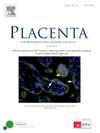DEHP exposure alters carcinoembryonic antigen family member transcript levels and modulates responses to activin A in the murine placenta
IF 3
2区 医学
Q2 DEVELOPMENTAL BIOLOGY
引用次数: 0
Abstract
Introduction
Activin A affects placental decidualisation and trophoblast growth and invasion. Levels increase during pregnancy, peaking at parturition, while premature elevation is a hallmark of several pregnancy disorders. We examined the impact of unopposed/elevated activin A bioactivity in the inhibin α knockout (Inha KO) mouse placenta which lacks competitive inhibition by inhibin A. We also investigated whether simultaneous exposure to the endocrine disruptor, diethyl-hexyl phthalate (DEHP), which impairs normal placental function and affects activin A signalling in other organs, exacerbates morphological and transcriptional effects.
Methods
Litters of Inha WT, Het and KO fetuses were collected at E15.5 from time-mated Inha heterozygous pregnant mice randomly assigned to three groups: untreated, corn oil (Vehicle) or DEHP 500 mg/kg/day, from E12.5–14.5 (n = 2–17). Gross and histological placental morphology was analysed, and bulk RNA-sequencing conducted.
Results
Placentae of Inha WT, Het and KO fetuses exhibited no gross morphological differences or differentially expressed genes. However, WT males compared to WT females displayed significantly increased placenta size and labyrinth area. DEHP exposure significantly increased fetal resorption at E15.5 but yielded limited differences in placental morphology. Sex- and genotype-specific transcript alterations in DEHP-exposed placentae included four carcinoembryonic antigen family transcripts (Ceacam13, Gm5155, Psg18, Psg-ps1) and four additional trancripts (Cts3, Ssr4, Sec11c, Taf7l) altered in all genotypes.
Discussion
Despite minimal morphological changes, transcriptomic differences suggest that spongiotrophoblast cells and syncytiotrophoblast giant cells are DEHP exposure targets, with carcinoembryonic antigen family transcripts susceptible to its effects. Additionally, DEHP modulates placental gene transcript levels when activin A is unopposed in vivo.
DEHP暴露会改变鼠胎盘中癌胚抗原家族成员转录水平并调节对激活素A的反应
激活素A影响胎盘脱细胞和滋养细胞的生长和侵袭。在怀孕期间水平增加,在分娩时达到峰值,而过早升高是几种妊娠疾病的标志。我们研究了未对抗/升高的激活素A生物活性对抑制素α敲除(Inha KO)小鼠胎盘的影响,该胎盘缺乏抑制素A的竞争性抑制。我们还研究了同时暴露于内分泌干扰物邻苯二甲酸二乙酯(DEHP)是否会损害正常胎盘功能并影响其他器官的激活素A信号,从而加剧形态学和转录效应。方法在E15.5时采集Inha杂合妊娠小鼠的Inha WT、Het和KO胎仔,随机分为3组:未处理、玉米油(Vehicle)或DEHP 500 mg/kg/day, E12.5-14.5 (n = 2-17)。分析胎盘大体和组织学形态,并进行大量rna测序。结果Inha WT、Het和KO胎胎盘无明显形态差异和基因表达差异。然而,与WT雌性相比,WT雄性显示出明显增加的胎盘大小和迷宫面积。DEHP暴露显著增加E15.5胎儿的吸收,但对胎盘形态的影响有限。dehp暴露胎盘的性别和基因型特异性转录物改变包括4个癌胚抗原家族转录物(Ceacam13, Gm5155, Psg18, Psg-ps1)和4个其他转录物(Cts3, Ssr4, Sec11c, taf71)在所有基因型中改变。尽管形态学变化很小,但转录组学差异表明,海绵滋养细胞和合胞滋养细胞巨细胞是DEHP暴露的靶标,癌胚抗原家族转录物易受其影响。此外,当激活素A在体内无对抗时,DEHP调节胎盘基因转录水平。
本文章由计算机程序翻译,如有差异,请以英文原文为准。
求助全文
约1分钟内获得全文
求助全文
来源期刊

Placenta
医学-发育生物学
CiteScore
6.30
自引率
10.50%
发文量
391
审稿时长
78 days
期刊介绍:
Placenta publishes high-quality original articles and invited topical reviews on all aspects of human and animal placentation, and the interactions between the mother, the placenta and fetal development. Topics covered include evolution, development, genetics and epigenetics, stem cells, metabolism, transport, immunology, pathology, pharmacology, cell and molecular biology, and developmental programming. The Editors welcome studies on implantation and the endometrium, comparative placentation, the uterine and umbilical circulations, the relationship between fetal and placental development, clinical aspects of altered placental development or function, the placental membranes, the influence of paternal factors on placental development or function, and the assessment of biomarkers of placental disorders.
 求助内容:
求助内容: 应助结果提醒方式:
应助结果提醒方式:


